Ann Lethbridge's Blog, page 24
October 15, 2012
News
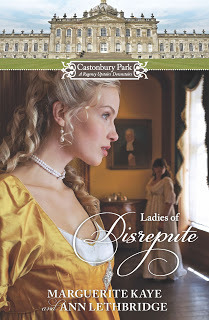 In case you are wondering where I was, I have been travelling again, so I can bring you more wonderful pictures of Britain. I have also been writing up a storm. With a book due at the end of September, I found myself running a bit behind. But here we are, all caught up and ready to plunge back in.
In case you are wondering where I was, I have been travelling again, so I can bring you more wonderful pictures of Britain. I have also been writing up a storm. With a book due at the end of September, I found myself running a bit behind. But here we are, all caught up and ready to plunge back in.First, I want to say that this summer proved to be one of those summers where outdoors was calling and I did not have the power to resist. Hence so little activity on the blog. Certainly most summers in the Toronto area are usually good, but this one was exceptional.
My needlework also suffered from lack of attention, so progress has slowed to a crawl, but I look forward to getting into it once the garden is put to bed. Pun intentional.
So on the writing side, Lady of Shame is due out next month. I hope you have been following along with the Castonbury Park series (think Downton Abbey) which started with the Wicked Lord Montague in August on Kindle in North America and in print in the UK. Each author brings something special to the series and we are all very excited about it. For those of you on my side of the pond who prefer their books in print, fear not. The first four are already slated for print, two per book and already available for preorder on line.
And if you enjoyed the Harlequin Authors' Round Robin earlier this summer, another one is slated for February. This one will be a readers choice of the final hero. So watch this space for more.
Next time we continue our visit to Buckland Abbey, so until then Happy Rambles.
Published on October 15, 2012 13:21
August 22, 2012
Fashion Summer 1812
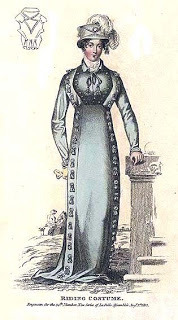 Fashion in Riding habits, this one for August 1812 from La Belle Assemblee.
Fashion in Riding habits, this one for August 1812 from La Belle Assemblee. This is without doubt a complicated outfit. Herewith the detailed description:
Made of ladies habit cloth or Moria Louisa Blue, trimmed down each side of the front with Spanish buttons, the waist rather long with three small buttons on the hips; a short jacket full behind, the front habit fashion with small buttons up the neck and a row of small buttons on each side of the breast; a lapel thrown back from the shoulders and trimmed with Spanish buttons, has a most elegant effect and gives a graceful finish to the dress.
The collar is made about a quarter inch in depth and fashioned negligently at the throat with a large cord and tassel; it opens sufficiently to display the shirt which is of lace in general but this article admits of considerable variations; some of our elegants wear a collar of lace to fall over, others have a shirt edged round the neck with a rich lace frill and not a few, in despite of the heat of the weather, envelope their necks in a large cravat of India muslin.
A small woodland hat, whose colour corresponds with the dress with two white ostrich feathers fastened behind and falling carelessly over the left side. A cord and tassel is brought round the hat and fastened near the top of the crown on the right side.
The description provides some other fashion notes with regard to fabric and the various styles of shirt worn beneath the habit. This plate also provides a sketch of what the jacket looks like at the back, where those three buttons at the hips appear to reside. I think this is a very elegant costume for our second year of the regency. I found the designation of the hat as "woodland" very interesting.
Until next time, Happy Rambles.
Published on August 22, 2012 18:23
August 15, 2012
Buckland Abbey, Devon
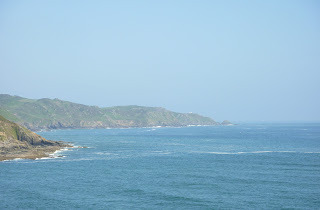 This year our explorations started from Salcombe in Devon. We stayed in a hotel on South Sands. We only had to cross a narrow road to get to the sand.
This year our explorations started from Salcombe in Devon. We stayed in a hotel on South Sands. We only had to cross a narrow road to get to the sand.On the beach we were able to pick up the ferry into town. Much easier than driving on the roads you saw on the blog yesterday.
This is a view from the headland just beyond our hotel. I have to say, it was a picture perfect day in Devon when we walked along the road up to the top of the hill. Such a pretty coast land.
This blog is not really about the seaside, but I was so pleased with this view, I thought it made a nice opening view.
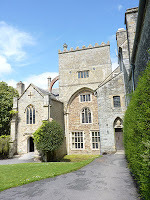
Buckland Abbey, was our first port of call (keeping to our seaside theme) The GPS sent us on more of those brilliantly narrow roads enclosed in high hedges, and it was a bit like being lost at sea. However, the journey through the countryside was as lovely as it was terrifying every time a car came the other way.
Originally a Cistercian abbey, the property was sold to Sir Richard Grenville during the Dissolution by Henry VIII. The view here is of the south front and its origins can clearly be seen.
It was later acquired by Sir Francis Drake and remained in that family until 1940.
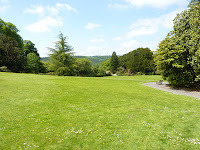
As usual, it is the late Georgian era of the house that interests me most, though it is hard to deny the fascination for one of England's heroes, Sir Frances Drake. Perhaps one day I will venture a story in those earlier times. This is one of the views a lady or gentleman in our era would have enjoyed. but Buckland was a farm when it was first built, to feed the monks and provide its wealth, and it was a farm during the Regency.
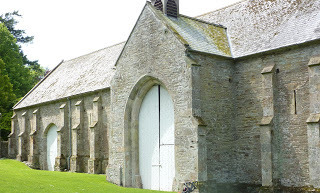 At first glance, this grand building might appear to be the outside of a church, but step inside and it is a completely different story.
At first glance, this grand building might appear to be the outside of a church, but step inside and it is a completely different story.It is in fact a barn. Known as the great barn and built by the monks it continued to be used throughout the centuries for the winnowing and storage of threshed corn (wheat, oats, barley).
The large door in the centre on this side of the building is matches by another on the opposite side, both havingt an upper pigeon loft, which just sneaks into my picture. Those doors were set opposite each other to create a cross-draught to help with winnowing. In 1792 thee additional doors were added at the ends of the building, which because it was too narrow for a wagon to turn around inside, allowed them to be driven from one end to the other. Previously the winnowed corn had to be flung from hand to hand to be stored at the far ends of the building. Here is a picture of the inside taken from one end and then the other.The narrow windows were for ventilation
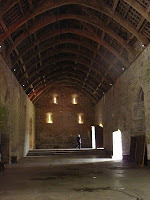
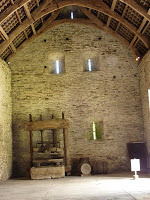 And that wonderful contraption in the corner on the right - a cider press. It was certainly in operation during the Regency because it is recorded that the original wooden screw was replace by an iron one in 1815. The journals from 1795 record the consumption of 26 butts and one hogshed of cider during the course of the year, or approximately 3,000 gallons. The apples were grown on the estate, so it would make sense that it would be a preferred beverage.
And that wonderful contraption in the corner on the right - a cider press. It was certainly in operation during the Regency because it is recorded that the original wooden screw was replace by an iron one in 1815. The journals from 1795 record the consumption of 26 butts and one hogshed of cider during the course of the year, or approximately 3,000 gallons. The apples were grown on the estate, so it would make sense that it would be a preferred beverage.It is thought that the arch-braced oak roof might have been thatched originally. It is hard to describe just how large this building is, but I think that the size of my brother in law at the far end of the building might just give you a sense of it. While there is a concrete floor in here now, until the 1950's it was beaten earth.
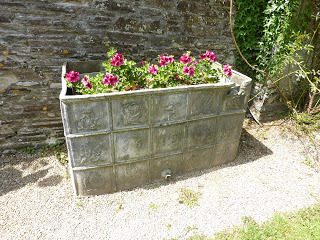 The next time we visit we will head towards the house, but in the meantime I will leave you with this picture of a medieval horse trough come planter, which I found enchanting. Until next time, Happy rambles.
The next time we visit we will head towards the house, but in the meantime I will leave you with this picture of a medieval horse trough come planter, which I found enchanting. Until next time, Happy rambles.
Published on August 15, 2012 19:54
August 13, 2012
Somewhere In Devon
I have a feeling this country lane hasn't change much over the centuries. The bushes on the banks touched both sides of the car. I found it a very unnerving experience, but also charming. Luckily we didn't run into anything coming the other way. If you are wondering about the time of year, it was May.
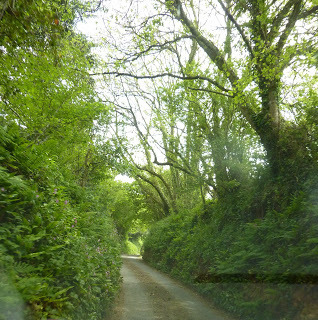
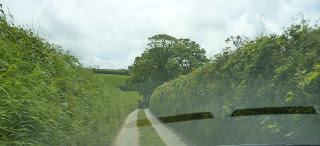
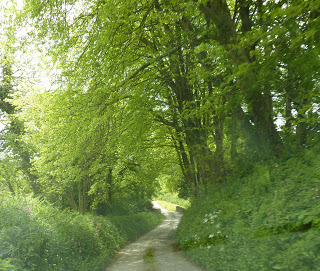 And so begins my next adventure searching for signs of Regency England.
And so begins my next adventure searching for signs of Regency England.
Until next time, Happy rambles.



 And so begins my next adventure searching for signs of Regency England.
And so begins my next adventure searching for signs of Regency England.Until next time, Happy rambles.
Published on August 13, 2012 19:56
July 25, 2012
Marnhull, Dorset
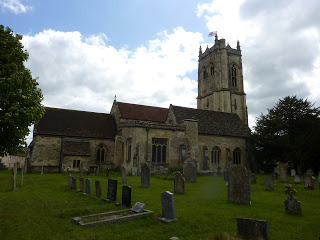 There has been a village in Marnhull since Saxon times. It is located in the Blackmore Vale an area often called Hardy country.The village has around 2,000 residents
There has been a village in Marnhull since Saxon times. It is located in the Blackmore Vale an area often called Hardy country.The village has around 2,000 residentsThe church, St Gregorys, is very old and well worth a visit. The first church was built on this site in the twelfth (isn't that such an odd looking word) century.
There is evidence of that church in the current building and one of the original pillars holds up part of the roof.
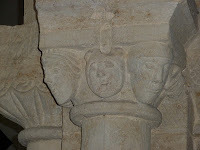
As you can see, whoever carved those original capitals had a sense of humour. The faces likely represent the men who worked on that first church. If so, it is nice that they have been captured this way, since rarely do we see the workers in portraits etc.
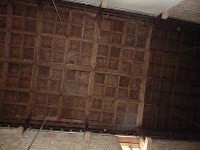
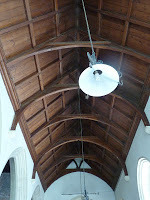 The church was enlarged on and off throughout the medieval period.The west part of the nave is coffered work from 1520 and there is a sixteenth century wagon roof in the north aisle.
The church was enlarged on and off throughout the medieval period.The west part of the nave is coffered work from 1520 and there is a sixteenth century wagon roof in the north aisle.  There is also a squint, or a hagioscope which permitted the congregation in the north transcept to see the high point in the mass when the consecrated host was elevated by the priest.
There is also a squint, or a hagioscope which permitted the congregation in the north transcept to see the high point in the mass when the consecrated host was elevated by the priest.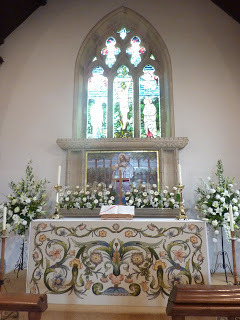 The altar is from the 17th century and here you see it decorated by the local ladies for the Jubilee celebrations.
The altar is from the 17th century and here you see it decorated by the local ladies for the Jubilee celebrations.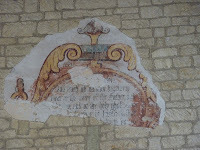
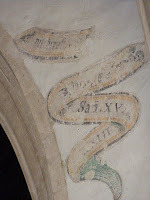 The original 16th century paintings of the ten commandments, of which only scraps remain, are mostly covered over by18th century paintings of the creed and the Lords prayer.
The original 16th century paintings of the ten commandments, of which only scraps remain, are mostly covered over by18th century paintings of the creed and the Lords prayer. I hope you enjoyed this visit to an ancient English country church, until next time, Happy Rambles.
I hope you enjoyed this visit to an ancient English country church, until next time, Happy Rambles.
Published on July 25, 2012 20:23
July 11, 2012
Sherborne
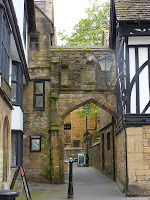
Some time ago, we visited Sir Walter Raleigh's Sherborne castle in Dorset. Nearby is the ancient and charming town of Sherborne.
Set on the River Yeo edging onto the Blackmore Vale, the town is a picturesque mix of buildings, including those from medieval and Georgian eras.
I loved this archway. Many of the buidings are constructed of ochre-coloured hamstone from Ham Hill in Somerset.
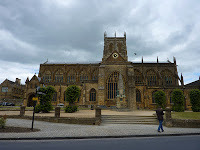 Sherborne was the capital of Wessex and two of King Alfred the Great's older brothers are buried here in the abbey.
Sherborne was the capital of Wessex and two of King Alfred the Great's older brothers are buried here in the abbey.The Abbey was once a saxon cathedral and is now the Parish Church.
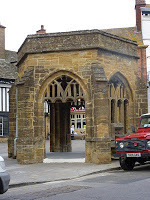
The Conduit is a hexagonal 16th-century building that originally stood in the cloisters on the north side of the abbey, where it served as a washing place for the monks. It was moved to the southern end of Cheap Street after the dissolution of the monastery in 1539.
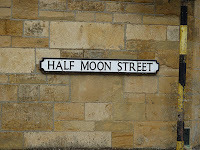
 I could not resist this street sign, since it also a street name that often appears in many of my favourite Georgette Heyer novels set in London. And of course there we find a 17century pub.
I could not resist this street sign, since it also a street name that often appears in many of my favourite Georgette Heyer novels set in London. And of course there we find a 17century pub.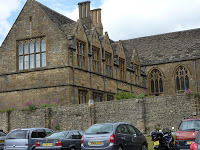
Sherborne School for boys was founded by King Edward VI and occupies some of the original Abbey buildings. I can imagine a Regency character attending school here, can't you?
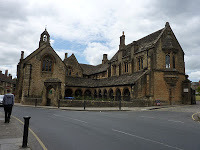
The St John's Alms Houses
This building was licensed by Henry VI in 1437 and was designed to house ‘twelve pore feeble---old men and five pore feeble---old women’. Copies of the royal license and foundation deed are on view in the antechapel.
The construction of the almshouse began in 1440; the chapel was completed two years later and the remainder of the building in 1445. Eighteen elderly people from the town are still housed there today. How about that for long term planning?
Here are a couple of lovely half timbered building from Tudor times.
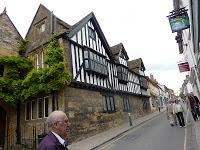
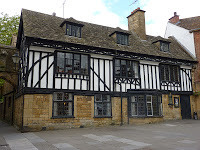
And last but not least, although there are many Georgian buildings in the town, I fell in love with this one.
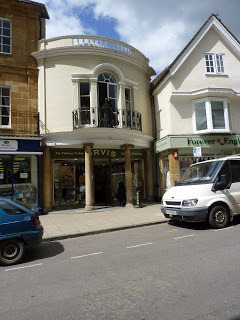 Built in 1818 it was originally the Sherbourne Bank for saving.
Built in 1818 it was originally the Sherbourne Bank for saving.And since I found my perfect Regency building, it is time to call it a day and wish you Happy Rambles Until next time.
Published on July 11, 2012 21:22
June 28, 2012
Find me
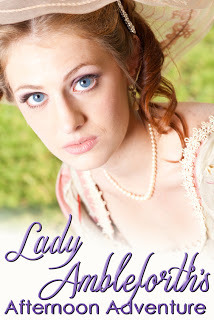 I do hope you have been following along. Saturday concludes our story. Can you guess who Lady Ambleforth chooses? http://harlequinhistoricalauthors.blogspot.ca/
I do hope you have been following along. Saturday concludes our story. Can you guess who Lady Ambleforth chooses? http://harlequinhistoricalauthors.blogspot.ca/
Published on June 28, 2012 06:37
June 25, 2012
Book News

It is always exciting when a new book comes out. Exciting and scary too. Here is my latest offering, The Laird's Forbidden Lady is now in stores and on li
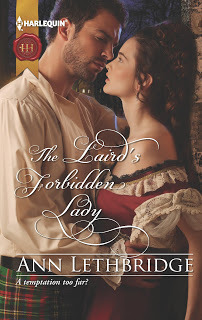 ne where ever you like to shop
ne where ever you like to shopIan Gilvry, Laird of Dunross, is as rough and wild as the Highland heather. Yet the return of Sassenach Selina and her family to claim his land ignites hatred and passion in equal measure.
Lady Selina is torn between family loyalty and wanton need for Ian. Tricked into marriage, she finds the laird fulfils her every burning desire. But Ian is a man bound by duty. Can Selina be sure that his heart belongs not only to his clan…but also to the woman he has made his wife?
This Regency is set in Scotland and has received a great review from Romantic Times which I am delighted to share with you:
For fast-paced, pulse-pounding action and adventure merged with a highly passionate romance, Lethbridge’s latest is hard to beat. The engaging characters, along with the plot, evoke the atmosphere, people and history of Scotland. Fun, fast and fabulous! - Romantic Times
Winner of the Romantic Times K.I.S.S. (Knight in Shining Silver) July 2012.
Buy here from Amazon.com: The Laird's Forbidden Lady (Harlequin Historical)

Buy here From Barnes And Noble

Published on June 25, 2012 18:03
June 6, 2012
Fashion 1812
Here we have some beautiful examples of day's worth of dress for March 1812. A walking and evening gown for the same month.
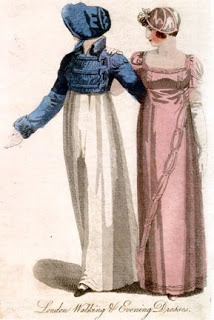
Taken from the Lady's Magazine and described as follows:
Walking Dress.
A spencer of blue silk, with facings, collar, wings, and cuffs of plush to match. --A bonnet composed of silk and velvet, to agree in color with the spencer.--Feather, the same.
Evening Dress
An evening dress f pink silk, either flowered or plain, trimmed with crape of the same color, and ornamented with small white buttons.--Cap of velvet and lace, trimmed with footing and a flower.
These two gowns to me seem to epitomize the Regency Era in their style.
Until Next Time Happy Rambles

Taken from the Lady's Magazine and described as follows:
Walking Dress.
A spencer of blue silk, with facings, collar, wings, and cuffs of plush to match. --A bonnet composed of silk and velvet, to agree in color with the spencer.--Feather, the same.
Evening Dress
An evening dress f pink silk, either flowered or plain, trimmed with crape of the same color, and ornamented with small white buttons.--Cap of velvet and lace, trimmed with footing and a flower.
These two gowns to me seem to epitomize the Regency Era in their style.
Until Next Time Happy Rambles
Published on June 06, 2012 23:00
June 3, 2012
Harlequin Authors Summer Beach Bag Contest
This is the first day of our Summer Beach bag contest.
Here is the Calendar of events to get you started. It's vacation season and excitement mounts as that long-awaited time at the beach approaches. To add to your anticipation, some Harlequin Historical authors are offering a bevy of prizes to fill your beach bag with fun items (and BOOKS of course!) for that relaxation time. Each participating author will have an activity planned on their website for their special day. You may be asked to comment on a blog, do a scavenger hunt, or visit a Facebook page. For each day you participate, your name will be entered into the Grand Prize drawing.Participating Authors
Here is the Calendar of events to get you started. It's vacation season and excitement mounts as that long-awaited time at the beach approaches. To add to your anticipation, some Harlequin Historical authors are offering a bevy of prizes to fill your beach bag with fun items (and BOOKS of course!) for that relaxation time. Each participating author will have an activity planned on their website for their special day. You may be asked to comment on a blog, do a scavenger hunt, or visit a Facebook page. For each day you participate, your name will be entered into the Grand Prize drawing.Participating Authors
Published on June 03, 2012 23:00



